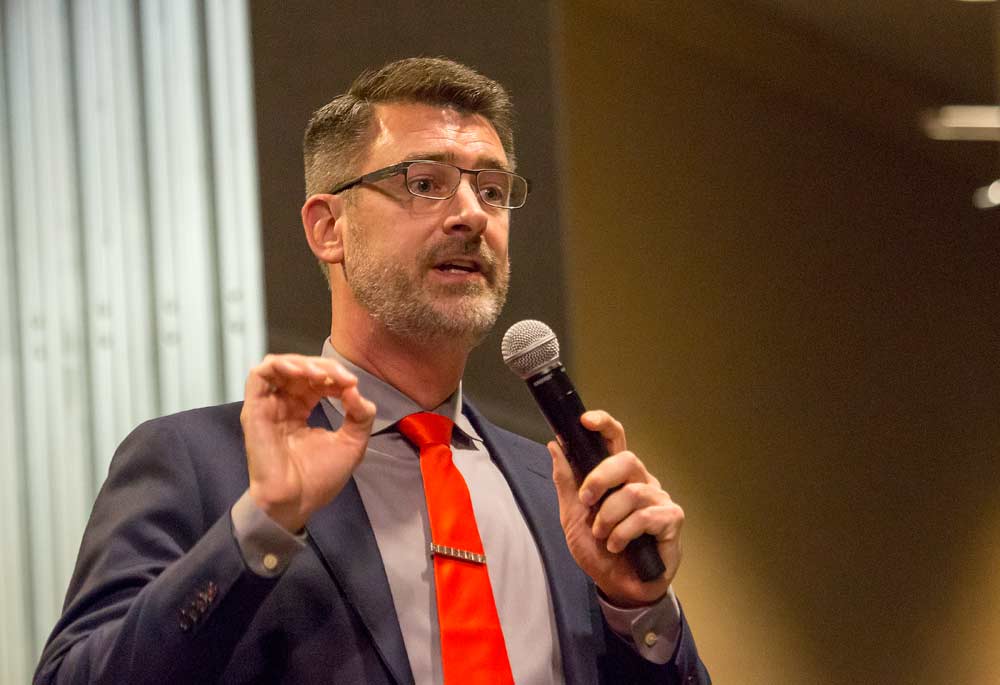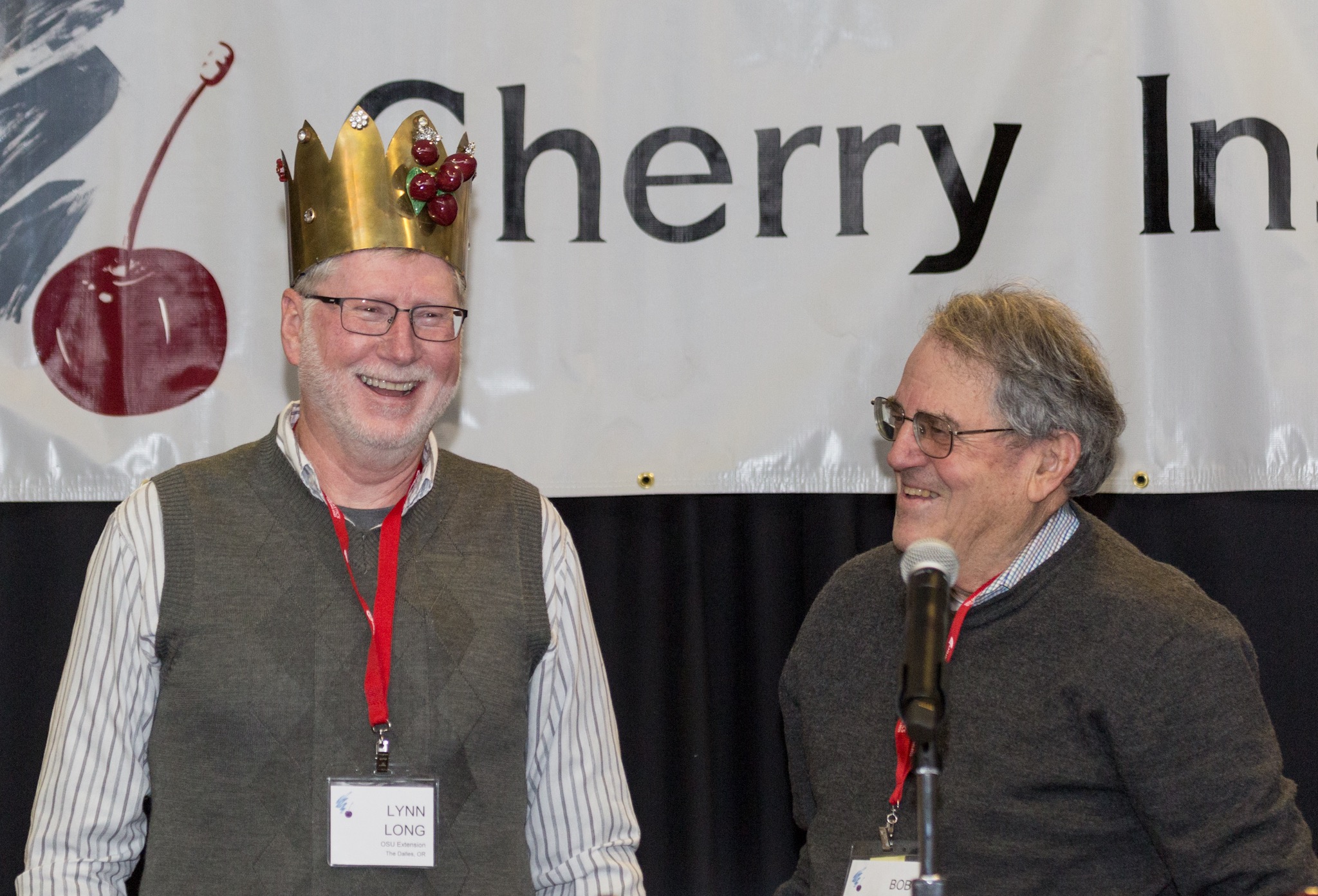
Peter Zeihan gives the keynote speech during the 2018 Cherry Institute in Yakima, Washington, on January 12. (TJ Mullinax/Good Fruit Grower)
Following a record crop year, Northwest cherry growers got several reminders about pruning, the latest word on powdery mildew, and updates on everything from new varieties to pollination Friday at the 75th annual Cherry Institute in Yakima, Washington.
Retailers across the U.S. and Canada loved the Northwest’s record 2017 crop of 26.43 million boxes, cherries were the No. 1 advertised product at retailers for four straight weeks, Northwest Cherry Growers President B.J. Thurlby said.
However, many growers have talked about trees being overset and cherries failing to size up.
“I have never seen the trees set from beginning to end the way we had this year, so this was just a huge crop,” Thurlby said. “We have to have the right fruit. Keep pruning.”
WSU horticulturist Matt Whiting echoed that point in a talk entitled, “Building Better Cherries,” noting that growers need to recognize crop load management is a 15-month process.
There are two key phases, he said, and growers tend to focus on the 60 to 85 days from bloom to harvest. “We are trying to learn more about how to maximize fruit quality potential at all critical stages.”
Lynn Long, a longtime Oregon State University horticulturist, was named this year’s Cherry King during the luncheon. Lynn spent 29 years as OSU’s extension horticulturist in The Dalles, Oregon, before partially retiring in 2017.
He studied plant pathology at Washington State University and has researched dozens of cherry varieties and rootstocks all over the world.
Before being crowned, Long gave a presentation of some of the most recent promising candidates for the variety trials he’s been running for more than 20 years.
His reviews included both fruit quality and harvest timing and suggested rootstocks and training systems for the dozen or so varieties that made it onto the recommended list. “It’s obvious that there are some new options in cherry varieties for Pacific Northwest growers. None, however, are perfect,” he said.

Lynn Long, left, is announced as the 2018 Cherry King by previous cherry king Bob Bailey at the annual Cherry Institute held in Yakima, Washington, on January 12, 2018. (TJ Mullinax/Good Fruit Grower)
Standouts include Royal Hazel, an early cherry developed by Zaiger Genetics of California, that is a large, flavorful cherry that harvests 11 days before Bing; Ebony Pearl, a Cornell University cherry that ripens with Bing but is very large and has good flavor; and Radiance Pearl, a Cornell-bred blush cherry that offers good resistance to cracking and pitting.
The keynote speaker, Peter Zeihan, painted a picture of a future world in chaos as the United States withdraws from its role as a global security stabilizer while the U.S. fruit industry seeks out niche trade partners.
“Let’s talk about the end of the world,” said Zeihan, an author and geopolitical analyst who bases global predictions on shifting demographics, political turmoil and geography.
With cynical humor, Zeihan predicts that America, specifically American farmers, will greatly benefit from a new world order in which decades-old global alliances and agreements begin to break down into nationalism and populism.
His only caveat for cherry growers was that fresh fruit will still be considered a luxury, so the industry will have to seek out some of the few stable markets left standing, namely Indonesia, Malaysia and Vietnam.
The Northwest Cherry Growers, which represents fruit from five Northwest states, is already courting and developing markets in those countries. Zeihan also suggested adding Mexico to the list.
In terms of Pacific Northwest sales and promotions, international marketing plans include a continued focus on Mexico and China, specifically second-tier cities, and a “wait and see” approach to Japan, the United Kingdom and Brazil, said Keith Hu, director of international operations for Northwest Cherry Growers.
On the pollination front, WSU’s Tim Lawrence urged growers to maintain orchards with many different kinds of flowers to stimulate bees to build larger broods. That, he said, will prompt them to pollinate more. “You want to them to be jazzed up as much as you can,” he said.
Yes, neonicotinoids, a controversial pesticide, are harmful to bees but planting a wider array of flowers for a more diverse habitat would do more good than simply banning a chemical, he said.
Lawrence, a regional extension honeybee specialist on Whidbey Island, also suggested creating an environment for native pollinators and rented honeybees because all species will then compete and pollinate more aggressively.
Also, using controlled-atmosphere storage for bee colonies may prove to have some benefits, though details like idea carbon-dioxide rates and temperature still need to be worked out, he said.
Growers also had a warning from Gary Grove, director of WSU’s Irrigated Agriculture Research Extension Center, about the potential for another bad powdery mildew year.
Enough inoculum survived the 2016-17 winter to make 2017 a bad year, and that means even more inoculum heading into 2018.
He also raised concerns about the potential for fungicide resistance, with widespread resistance to fungicides in the same class reported in grapevine mildew this year.
“Even though they are caused by different fungi, they are epidemiologically similar in their disease cycle,” he said. “Given some of the stories I’ve heard from some of the field people, I’m starting to think we need to take a look at this.”
He advised growers to start spraying early this year with softer treatments, to work up to the stronger fungicides — and don’t apply fungicides in the same class more than two or three times over the season, and never in consecutive sprays.
– by Ross Courtney, Kate Prengaman and Shannon Dininny






Leave A Comment